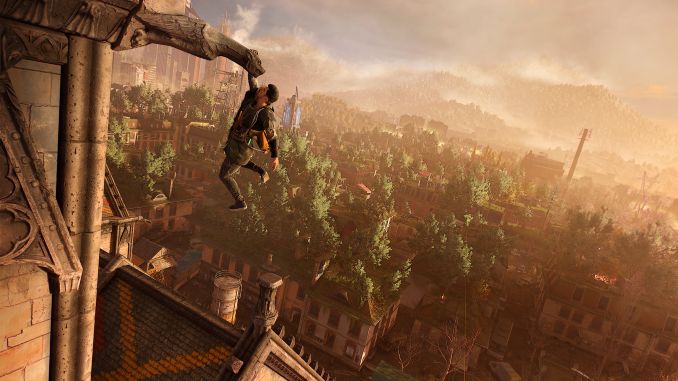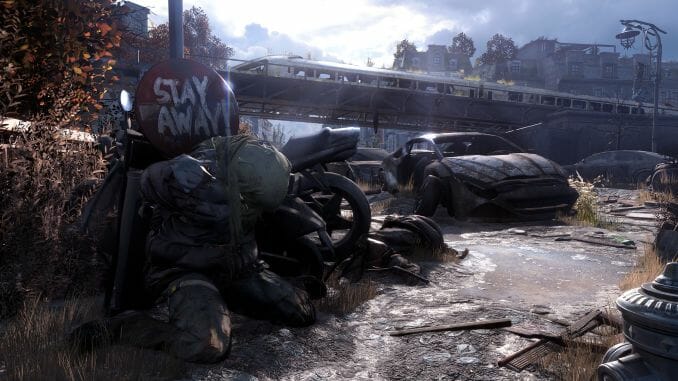Less than an hour into Dying Light 2, the game introduces its villain. His name is Waltz. He is the version of the charismatic post Dark Knight villain that has in the past decade become the legally mandated focal point of every game inspired in any way by Far Cry. This is the scene the introduction has been building up to, the emotional lynchpin on which the next 30-300 hours must rest. This is Vaas sitting in the sand and telling you about the definition of insanity. Waltz enters as you hide in a vent, and delivers his grand speech: when he was a kid, his daddy raised horses, and when his prize horse was injured, his daddy made him shoot it. If Dewey Cox were in a Ubisoft game, this is word for word what he would say.
Let us not beat around the bush: the story of Dying Light 2 is an unmitigated disaster. I lead with this because the game does. It has ambitions of being a serious roleplaying game, its sights set firmly on coming for Fallout: New Vegas’ post apocalyptic multi-faction throne. Yet its foundations are so rotten that any occasional bright spot, any flourish that a particular writer is able to sprinkle into their quest or character dialogue, only serves to draw further attention to the simple fact that nothing in the game makes any sense.
Dying Light 2 takes place in Villedor, the last remaining large city on an earth that collapsed to the Zombie Apocalypse. It is 15 years later, and you must navigate the various factions vying for power in the city while embarking on your own quest to find your long lost sister. Unfortunately, that factional interplay is reduced broadly to a series of rote choices between The Peacekeepers and The Survivors, two of the most poorly defined factions a videogame has ever seen. The Peacekeepers are a metaphorical stand-in for the US Army, spoken of explicitly by some survivors as occupiers whose presence disrupts their freedom, and by other survivors as cowards whose withdrawal to the core leaves them undefended. The Survivors are simply everyone else, not a coherent collective in any meaningful way except the game needed another faction to level up.
You are repeatedly presented with this choice between “order” and “freedom” as if these two concepts are immutable axioms and not complex terms whose positions require constant negotiation. The Peacekeepers are an army without a state, so whose order do they bring? Do Survivors, beset by gang wars, not seek order of their own? Hang on a second, this side quest just said a man remortgaged his house. From who? Are there banks? Hello?? It’s best not to think about it. Order helps you kill more zombies. Freedom helps you do parkour. I chose the side that helped me do parkour.
Because when the bad cutscenes subside, Dying Light 2 is still a videogame. It is the most videogame. There is so much videogame contained within that it could very well be the only videogame you play all year. Which raises a very simple question: why? What mechanical or emotional pleasure does Dying Light 2 seek to provide to make it worth players investing weeks if not months of their lives into it? And the answer is multi-faceted, incoherent and more than a little tragic.

A simple answer would be none, and then we would be done here. The melee combat system is simplistic beyond all reason, with canned counter attack QTEs that barely punctuate the dull depressing violence of limply swinging your ax until the human being in front of you explodes into meat. This accounts for a solid 20% of the game, and every second of it sucks.
But it’s not the whole picture. Far and away the best part of the game is the parkour system. Moving around the Old Town brings to mind the highs of early Assassin’s Creed, as the routes from the street to the rooftops gradually become second nature, and a map of the city starts to form in your mind. This interplays with the resource system, and a strict day-night cycle. At first it’s a little mind-numbing being overwhelmed by the amount of systems put in your face to make the numbers go up. There’s looting, there’s crafting, there’s weapon durability, there’s weapon ranks and armor ranks and ability trees and so on and so on. But five hours in you may find yourself trapped deep in hostile territory as the sun goes down, using the items you found and your knowledge of the city to carve out a route to a rooftop and make it back to safety before you are completely infected, and like a truck it hits you: this game was designed. By real human beings.
It is easy to think of AAA games as soulless, the contributions of the countless workers crushed into something unrecognizable by a cruel production process that discards those workers and rewards those who abused them. Certainly that describes the reported development process for this game. But the final product leaves traces where systems do cohere into engaging cascades of quick-fire decisions, or platforming obstacle courses where simple movements tell a story guided by the level designer’s careful hand. To play Dying Light 2 is to stumble aimlessly through a graveyard of countless better games that will never get to exist. To experience fleeting moments that remind you this is a game made by people; talented and passionate people trying to communicate something that genuinely excites them, before those sparks of life are crushed one by one by the unquenchable content machine.
After you leave the Old Town, a smaller introductory area that you’ve learned your way around during the game’s initial hours where the parkour all cohere the strongest, you arrive in the main city, covered in huge skyscrapers. No longer can you navigate careful routes between the streets and the rooftops. Instead the game gives you a paraglider, unwieldy and slow, and limited by your stamina meter. The game cuts its own legs out from underneath itself, and does so proudly for a back of the box feature. Anybody familiar with Dying Light’s design can see how bad an idea this is from miles off, and obviously part of the team did because this is the exact moment that the game introduces fast travel. But it doesn’t matter. It was in Breath of the Wild. And that’s one of the best games ever made.
Dying Light 2: Stay Human was developed and published by Techland. Our review is based on the Xbox Series X|S version. It is also available for the PlayStation 4, PlayStation 5, Xbox One, PC, and Switch.
Jackson Tyler is an nb critic and podcaster at Abnormal Mapping. They’re always tweeting at @headfallsoff.

